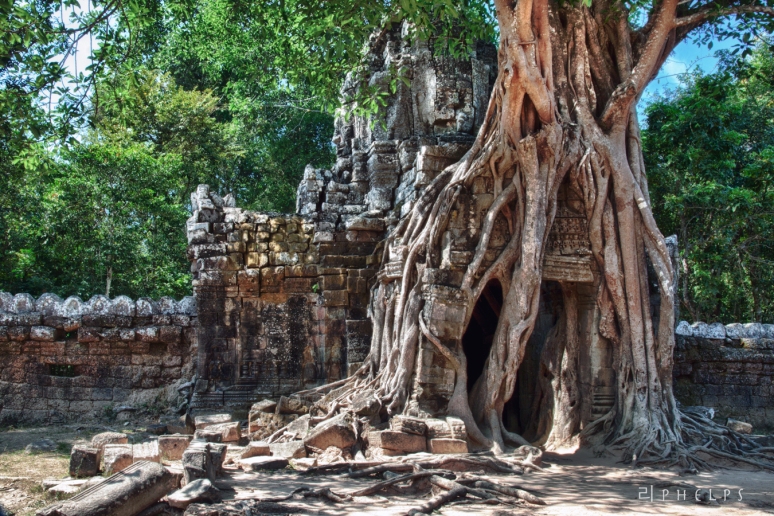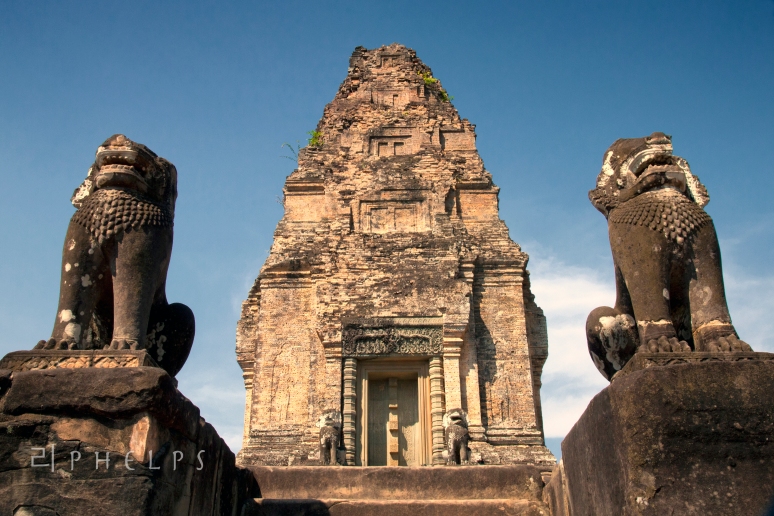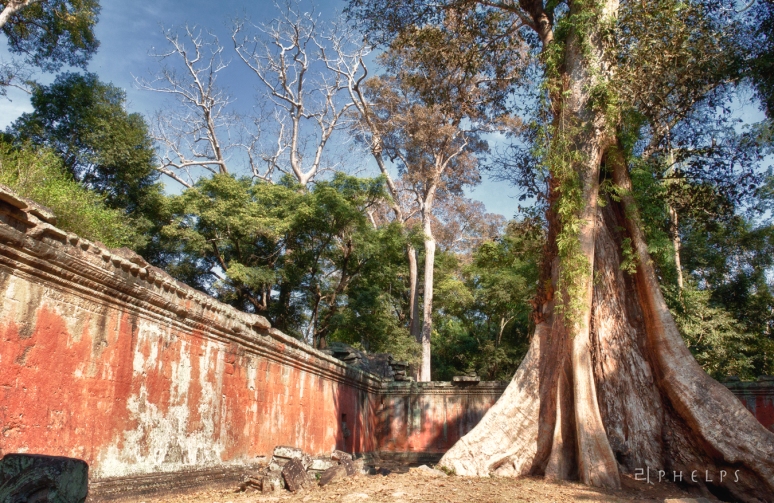The Temples of Angkor: Part III
When we visited Ta Prohm on Wednesday, we knew this was a temple to see twice. However, we didn’t want to see it until later in the day, so today we planned to visit some other major sites on the Angkor circuit before arriving at the famous Ta Prohm.
Mr. Tong took us first to Preah Khan, which means “Sacred Sword.” This site, dedicated to 515 divinities in 1191 AD is a maze of well-preserved corridors and vaulted pathways.

Preah Khan's Vaulted Corridors

Preah Khan Panorama

Preah Khan Passageway
Just east of Preah Khan is Preah Neak Poan. Walking over the water on an elevated deck through marshy jungle, our expectation was built up to see this island temple. But we were let down when we reached Neak Poan and we could only view it from a distance. A long wooden fence barred our entry.
Hopping back in the tuk tuk, we headed to Ta Som. Besides the historical motivations, the main draw of this temple (for a photographer such as myself), is the large tree that engulfs the eastern gate.

Ta Som

Ta Som's Eastern Gate
From Ta Som, we tuk tuked (do you like my made-up verb?) it to East Mebon. We’ve both come to a deeper appreciation for the beauty and strength of elephants through our travels in southeastern Asia, so we were excited to find four identical stone-carved elephants guarding each of the four corners of this temple.

Stone Elephants Stand Guard

East Mebon's Upper Tier

East Mebon Panorama
At East Mebon, the light was right, the sky was clear and deep blue, and the composition was perfect. We couldn’t pass up the opportunity to make a fun time-lapse of us goofing around. In order for us to make a fifteen second video clip, we had to jump around in front of the camera for six minutes. In 85+ (30 Celsius) degree heat, that meant we were drenched in sweat by the time my camera had fired 360 photos.
After catching our breath and wiping the sweat from our eyes, we cooled off as the wind whipped our bodies in the back of the tuk tuk. Our last stop was a re-visit of Ta Prohm, the jungle engulfed temple made even more famous by Angelina Jolie’s “Tomb Raider” film, shot partly on location.
A second visit was definitely worth our time as there is so much to see and photograph. I shot as many trees wrapping their roots around the temple as light allowed. Being that we’ll likely never be in this part of the world again, I let my memory cards fill up with reckless abandon.

A Tree Clings to the roof of a covered walkway.

Nature is Recapturing Ta Prohm
It’s not just that trees cling to roofs in Ta Prohm that make the atmosphere so unique. It’s also the fact that many of the trees are MASSIVE. To give some scale, the red wall in this next photo is around ten feet high.

An Outer Red Wall, and a Massive Tree in Ta Prohm
If you’re struggling with understanding the size of the trees, take a look at these photos of my wife and I. I’m six feet, two inches (188 cm), and I feel like a dwarf in Ta Prohm’s jungle.

Two Giant Trees and a married couple.

A Photographer's Playground

The Iconic Tree # 2

Ruins of Ta Prohm
By the end of three days of temple hopping around the brilliant Angkor empire, we were exhausted…but not finished. We still had much more to see and photograph. In an effort to change up the pace and take in some different aspects of Khmer culture, we decided to visit a local silk farm on day four of our trip.
Sign up to receive email notifications and find out when I make a post! “The Temples of Angkor: Part IV: Detour” is coming soon! The detour includes a silk farm tour, and concludes with a sunset at Pre Rup.
Thanks for taking the time to check out this blog!

I am sooo drooling over these. One day I’ll be the one posting these photos. Your takes are just gorgeous!
I started following your blog at Temples of Angkor Part 1, and am so hungry for more! Keep it up 🙂
Sorry for the replying under this comment – I couldn’t reply to your comment above…
It’s a truthful comment and compliment. Sorry, I don’t just compliment, I also post if I don’t like the post. As for this one …it’s a compliment. You can tell the author has some photographic ability and that the lack of sharpness really looks like it’s due to resizing. So it’s a compliment to the author and a “negative” to the software WP uses to resize…
I’ve done a test with a file at 300dpi compared to the 150dpi version, but WordPress significantly compresses the photo. The original TIF version is a crisp file that tips the scales at 75mb. The jpeg version I uploaded here is only 5.5mb, but after being squeezed through WordPress’ software, it went down to .5 mb! That’s a crazy amount of compression and leads to some of the slight blurriness in a few of the HDR photos.
Either way, I appreciate the constructive criticism as it helps me create a better blog.
Great! Thanks! I’m really glad you’ve been enjoying them!
Wow- just amazing! Thanks for sharing with us!
Thank you! I’m glad I had the chance to share with you!
amazing, i loved the time lapse freaking hilarious, those trees are amazing awesome work
Thanks brother! I’m glad you liked the time-lapse!
pictures are looking great! XOXO!
Brings back good memories. Mesmerising place.
These are fantastic, and I love seeing all the different angles of this place!
Thank you! It became a challenge after a while to get new and interesting angles while shooting at the temples. Some shots started to repeat themselves, but I’m glad you like them!
Loved the video and sweet pics!
The video was awesome… great shots with a fun quirky twist. The music wasn’t what I expected and gave it a really fun, cheery aspect.
The time lapse was hilarious…I loved it. Great job at capturing your experiences. Love the trees and how their roots engolf parts of the building. And amazing how they built these beautiful structures!
Thanks sister! I knew you would like the goofy video. Thanks for being a fan…it’s encouraging!
Amazing pictures! I read these posts and commented before I actually visited Angkor Wat and the surrounding temples (your pictures made high expectations and Angkor Wat did not disappoint), but now I have to see them again after having been there – somehow I can appreciate them even more.
I have to ask – how on earth do you get minimal tourists in your pictures?? Everywhere we looked there were people, people, and more people taking pictures of other people!
Anyway, thank you. I’m looking forward to your pictures of Vietnam, as we are in Ho Chi Minh City now and will be traveling in this country for the next 3 weeks…
http://oneworld4girls.wordpress.com/2012/03/20/the-city-of-temples-angkor-wat/
I’m glad you had a good time seeing Angkor Wat! As far as the tourists go, on the lesser visited temples it wasn’t too difficult. But on places like Angkor Wat and Bayon, ect., I did a lot of waiting. I’d set up my shot and then put my eye to the viewfinder, then as soon as a person left the frame, I’d shoot as many as possible. The Angkor Wat shot I took of the whole temple, I shot from the north side while the tourists navigated to the entrance on the west side. My other strategies involved getting to the temples either in early morning, or right before they closed. That especially helped at Bayon. Have fun in Vietnam! I look forward to your posts!